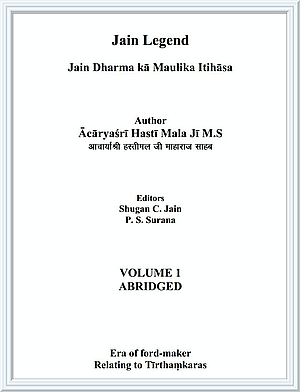In the Bharata region of Jambūdvīpa a great king named Samudra Vijaya used to rule over a city named Sāvatthī. His chief queen was named Bhadrā. Both the king and queen were religious and just. One night the queen saw the 14 great dreams. Interpreters of dreams told the king that according to these dreams the soul that has entered the queen's womb shall grow up to be a cakravartī emperor. Upon completion of her pregnancy period the queen gave birth to a bright and beautiful son. King Samudra Vijaya named him Maghavā. With proper training and upbringing when Maghavā became a young boy he was married off to virtuous girls. After 25000 years of youth, immersed in learning and knowledge, King Samudra Vijaya anointed him over the throne. For 25000 years he ruled as a provincial king. In his reign a cakrajewel appeared in the armoury / weaponry on account of which king Maghavā spent 10,000 years in expedition of conquest of six khaṇḍa (divisions). Ruling over the six khaṇḍa of Bharatavarṣa for 39000 years as cakravartī emperor, he became a monk. For 50,000 years he observed the conduct of a Śramaṇa monk and in the end, completing 5 lakh years, he became a god in the third heaven.
Concerning heavenly abode of cakravartī Maghavā, Verse number 57 of Titthogālī Painnaya states that eight out twelve cakravartīs attained liberation. Two cakravartīs namely Subhuma and Brahmadatta attained seventh hell while other two cakravartīs namely Sanatkumāra and Maghavā attained abode in third heaven.
Few scholars believe that Maghavā cakravartī attained liberation, and didn't go to heaven. To corroborate this, they cite references in the Uttarādhyayana Sūtra, 18th chapter 'Sajaijjaṃ', where, among the souls that gained Mokṣa, are included Bharata, Maghavā and Sanatkumāra cakravartīs. In the aforesaid chapter, in the 35th verse the term 'parinivvuḍe' is used for Bharata and Sagara cakravartī; the 38th to the 43rd verses (Gāthās) use the term 'patto gaimaṇuttaraṃ' for Lord Śāṃtinātha, Kuṃthunātha, Aranātha and cakravartīs Mahā Padma, Hariṣeṇa and Jayasena. In contrast to this in the 36th Gāthā the term 'pavvajjamabhuvagao' for Maghavā cakravartī and in the 37th Gāthā, 'sovi rāyā tavaṃ care' is used for Sanatkumāra. If the last portions of the Gāthā 37 and 38 had been, respectively, 'Maghavaṃ parinivvuḍo' and 'patto gaimaṇuttaraṃ', then it can be certainly concurred that they attained liberation. At the same time, in the Sthānāṃga Sūtra, the verse 'dīheṇaṃ pariyāeṇaṃ sijjhai jāva savvaḍukkhāṇamamṃtaṃ karei' is used for Sanatkumāra, which means he became liberated.
"Caittā bhārahaṃ vāsa, cakkavaṭṭī mahiḍḍhio
Caittā uttame bhoe, mahāpaume tavaṃ care"
In this, "mahāpaume tavaṃ care" is used for Mahāpadma, which on account of an error in printing in the first edition of the "Basic / Fundamental History of Jain Religion", 1st volume, was printed as "patto gaimaṇuttaraṃ" and 37th Gāthā for Sanatkumāra, 41st Gāthā for Mahāpadma "tavaṃ care" being used, even then, Mahāpadma unquestionably is considered to have attained mōkṣa while Sanatkumāra (not in the Titthogālī but according to Ṭhāṇāṃga) is considered to have been liberated. Thus, it is possible that all the souls described in 18th chapter gained mōkṣa.
 Acharya Hasti Mala
Acharya Hasti Mala
